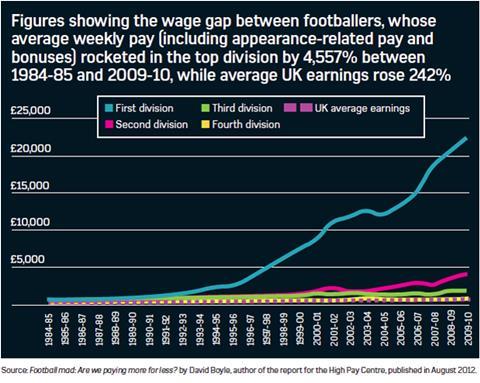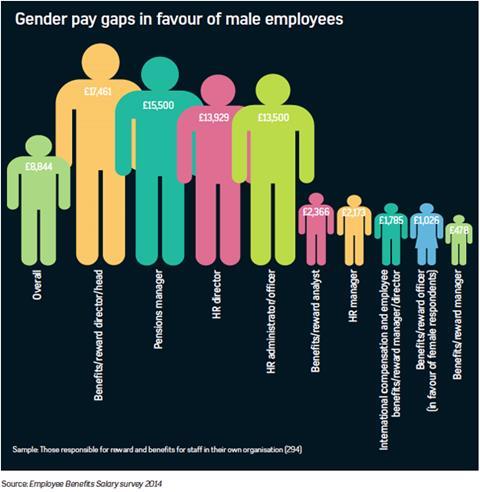
If you read nothing else, read this…
- Lower-paid staff need to see that high pay is earned.
- This relies on employers having transparent pay policies.
- Recognition programmes can help to keep lower-paid staff motivated.
The row was fuelled by a job advertisement for a lead kitchen porter at Arsenal’s Emirates Stadium, placed by Arsenal sub-contractor Delaware North Companies, which offered a starting wage of £8.28 an hour, including holiday pay. London’s living wage rate rose by 25p to £8.80 an hour in November 2013.
The Premier League club, which reported a total wage bill of £143 million for the 12 months to 31 May 2012, denied the allegations.
The ramifications of pay inequality are potentially catastrophic. A report by The Work Foundation, entitled Compensation culture: Is executive pay excessive? Does it matter? , written by Stephen Bevan, director of the Centre for Workforce Effectiveness, and published in November 2013, suggests that the financial crisis has broken the bond of trust between senior executives and many employees.
This situation, the report goes on to argue, is being exacerbated by executives’ bumper pay deals, which many staff deem to be inappropriate and unethical in a post-recessionary environment.
Creating a pay policy based on fairness is one of the best ways employers can remedy pay inequality within their organisation and help to keep staff motivated. Fairness tends to be based on the extent to which lower-paid employees believe their higher-paid colleagues earn their pay.
Duncan Brown, principal, reward and engagement at Aon Hewitt, says: “Fair has a straight impact, but it’s the most difficult to address.”

Helen Kersley, head of the Valuing What Matters team at think tank the New Economics Foundation, says employers should focus on linking pay packages to business performance, so lower-paid staff can see a clear correlation, and hopefully justification, for peers’ higher pay awards and remain focused in their role.
“Chief executives shouldn’t be having pay increases over and above what the organisation has achieved in terms of growth,” she says. “But even if an organisation’s performance improves, how much can [employees] actually attribute that to the chief executive?”
Kersley says performance is achieved by teams of people working together, which is why it is unacceptable and unfair for an employer to give a few executives staggeringly higher pay packages than others who are part of the same team.
Union premium
Kersley believes employers can correct this imbalance by increasing lower-paid employees’ negotiating power through, for example, trade unions. “There is good statistical evidence, not just in the UK but in Europe and further afield, that there is what is famously called the union premium,” she says.
“Where workplaces are unionised, they tend to achieve better rates of pay for the average worker and therefore reduced ratios for top and bottom staff.”
She adds that unionised employers are more likely to offer lower-paid employees better working conditions as well as better pay, which helps to keep them motivated.
Pay caps may also help to motivate lower-paid staff, which explains why Switzerland is debating a proposal to make it illegal for employers to pay any employee more than 12 times the wage of their lowest earner.
In the UK, the John Lewis Partnership, for example, caps the pay of its chief executive, Andy Street, to 75 times the salary of the organisation’s lowest-paid employee.
The key to this approach is to consider chief executive pay alongside the pay packages of the total workforce, rather than in the context of executive pay. “Employers have to justify taking their chief executive out of pay chats,” says Aon Hewitt’s Brown.
He adds that employers could also consider creating a logical process to explain their chief executive’s pay package to help keep lower-paid staff motivated.

The New Economic Foundation’s Kersley confirms the importance of pay transparency, and cites Norway as an example for UK employers to follow.
“Everything [relating to pay] is on the table in Norway, for example, so it’s very clear who is earning what and what the pay increases are,” she says. “So, if the chief executive is set to have a 10% pay increase, but the average worker is only set to have a 2% increase, it is on the table and everyone can see it and questions can be asked. But we don’t have that in the UK.”
Autonomy
For now, employers could instead focus on increasing the autonomy they allow employees to have in their roles, as well as offering, or increasing access to, training and development programmes . Kersley adds: “It’s about opportunities for staff where they think they can progress, not necessarily up a ladder, but using different skills, and the motivating effect of that. Staff are valued in a non-financial sense.”
Discount cards can also help to motivate lower-paid staff, as can recognition programmes , particularly as they tend to operate throughout a workforce, regardless of employees’ pay levels.
Reward scheme provider Love2reward decided to pilot its new staff discount card scheme internally. Alex Speed, head of corporate sales, says: “We have extremes of pay, with about 35% of the business still in Christmas savings clubs, and high-street vouchers for lower-paid staff.”
Love2reward launched its discount card scheme, Everyday Benefits, in August 2013 to staff that were initially sceptical, says Speed. “The attitude was that they’d rather have a £2,000 pay rise, but when I actually explained to them what the savings were, they saw that the card was almost better than a £2,000 pay rise by getting the discounts,” she says.
“When they realised how much money they could save, the employees that were not so positive are now those that have actually been loading money onto the card, especially at Christmas. They’ve looked at it almost as a pay rise.”
Paul Bartlett, head of employee reward and benefits at reward programme provider Grass Roots, says: “Recognition, at its most basic level, is all around employers saying thank you for doing a good job, and that’s applicable to everyone in the organisation. Staff need to understand that they are recognised for the role they play in the organisation being successful.”
Recognition programmes aim to engage staff at all levels and are particularly effective when based on peer-to-peer recognition, rather than executive praise, says Bartlett.
And rewards need not be expensive. These can range from extra time off work to gadgets such as iPads, with more aspirational rewards extending to holidays.
But whatever the reward, it must be given to employees by their manager along with a verbal thank-you. “It can’t be something that’s passive or done in the background,” says Bartlett. “The more public the way it is given, the more genuine it becomes.
“What you see, which is fascinating, is that even the highest-paid employee, for whom the reward itself may be fairly insignificant, values the public recognition involved. A lot of staff get huge bonuses, but they are not transparent.”
The motivational factor is that all staff are recognised in a fair and consistent way.
Bethany Powell: Employers need to develop transparent reward policies

One of the main considerations for employers when setting pay is aligning it to the market rate for the role in question. This is largely driven by three factors: the skills and competencies required for the role; the degree of accountability and impact on the overall performance of the organisation; and the relative supply and demand for the role.
Once a market rate of pay is established, organisations will then assess factors such as internal equity, relative value of a role to the organisation, and individual circumstances, such as a recruit’s pay levels at their prior employer.
Role type variations
Based on the above factors, rates of pay can vary significantly by level or by role type. There is general acceptance among employees that the above factors lead to pay levels that are perceived to be logical, if not always fair. However, pay is not always a rational issue and there are many emotional factors that can affect employee motivation.
There are further steps organisations can take to avoid motivational problems when large pay disparities exist. These include developing clearly articulated reward principles, which are fair, robust and communicated to all employees.
Transparency of the pay process is more important than transparency of the pay levels themselves.
Employers should adhere to the reward principles when making pay decisions, whether in developing an overall pay framework or making individual salary decisions. They should also ensure the pay framework provides for sufficient reward for stretched performance, whether through merit-based salary increases, individual performance-based bonuses, recognition schemes, and/or career progression.
A core set of benefits that does not vary by level or role type should be provided for employees, to establish a baseline level of provision and to reinforce the culture of an organisation. Employers should also establish early career training or rotational programmes, which enable high-potential employees to upskill to, or move into, other, more attractive roles.
Bethany Powell is a senior consultant in Towers Watson’s UK rewards practice











